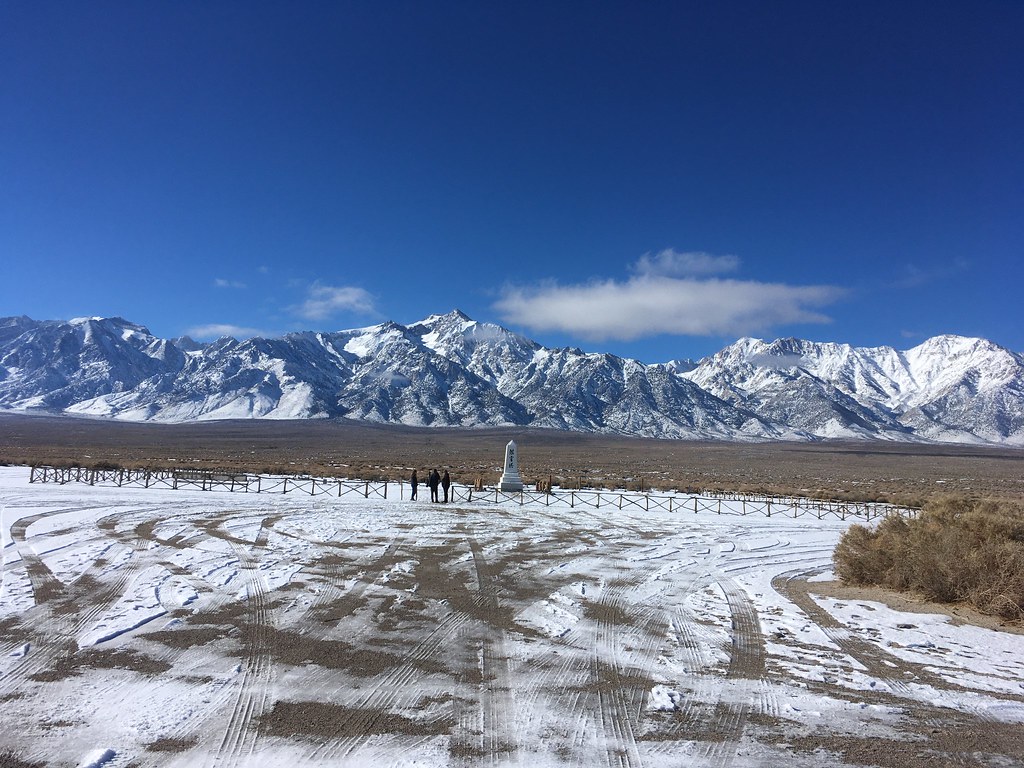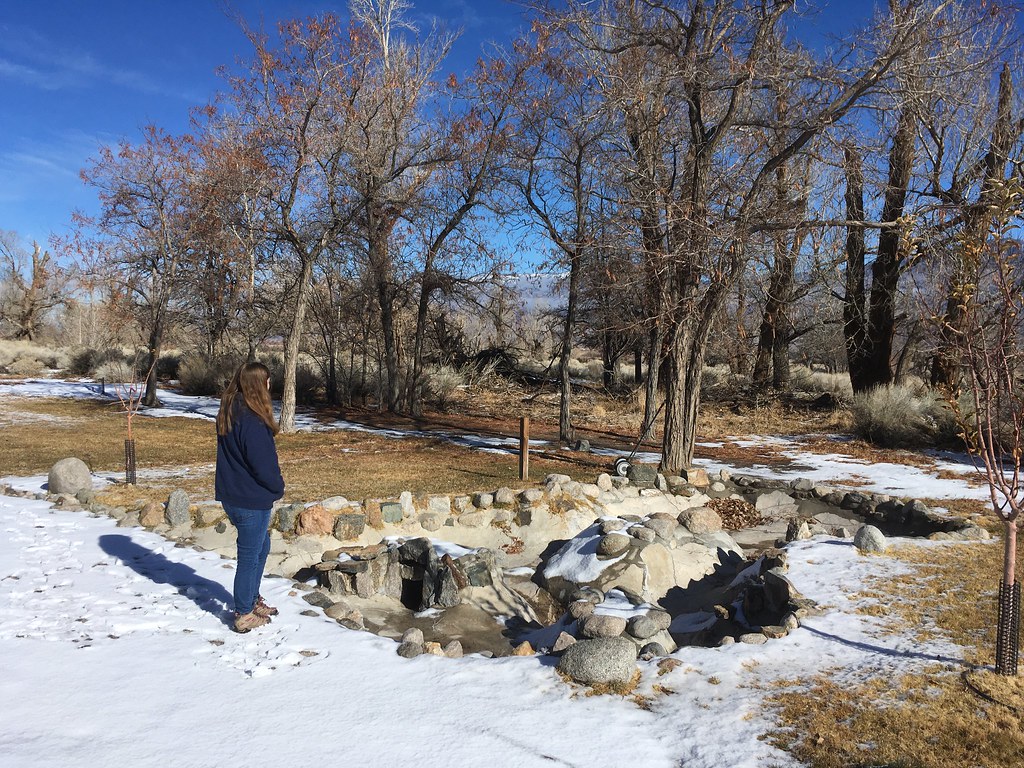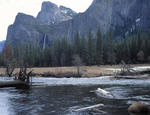
We must always remember what we, as individuals and as a nation, are capable of.
Depending on how you read it, that sentence can have widely different meanings. And that is why I wanted to visit Manzanar National Historic Site. That is why my family and I made the circuitous journey to the Owens Valley on the eastern side of the Sierra Nevada mountains. Because at Manzanar you can, in one place, witness both ends of that spectrum.
We arrived at Manzanar early on a chilly New Year's Eve morning. We entered the camp by driving past the unmanned guardhouse. (Or was it? Perhaps there are, in fact, ghosts at Manzanar). The visitor center was not yet open, so we took the driving tour and headed toward the partially rebuilt Block 14.

The guardhouse at the entrance to Manzanar War Relocation Center.
What built Manzanar? Fear built Manzanar. In some, it must be said, that fear was tinged with even darker and more sinister human emotions. But mostly it was fear that caused an encampment of ten thousand souls to spring up in an arid valley where once several hundred farmers grew apples until their water was taken from them, and before that indigenous people lived for centuries until their land was taken from them. With the residents of Manzanar, however, it was the other way around. They had something taken from them before they arrived – their freedom.
Freedom. The American West, with its expansive geography, is almost synonymous with that word. The Owens Valley where Manzanar is located exemplifies that association, broad and flat with sightlines that extend for miles, interrupted only by towering mountain ranges that jut toward the blue sky with in-your-face abruptness. This is beautiful country, although it is a stark beauty. On this morning that starkness was softened by the white blanket of a recent snowfall. I parked the car along the perimeter road and got out to soak in the beauty of that vast emptiness, and to reflect on one of the many ironies of this place: So many came to this part of the country to find freedom – economic, religious, or otherwise – but the internees of Manzanar came because they had lost theirs.

Mt. Williamson rises over Manzanar and the Owens Valley.
Of course, many internees lost much more than freedom. Some lost everything. But they had shelter… of a sort. They had food… in the mess halls at specified mealtimes. They had schools and employment… again, of a sort. They even had internal plumbing… just not internal to the buildings in which they lived. So, it could be argued, all we really asked them to give up was their freedom. But, from a different perspective, what did we give up in so asking? What did we as a nation forfeit by making that request?
In reality, it wasn’t a request. It was an order. Executive Order 9066 was issued in February 1942 and it, along with subsequent army proclamations, authorized the removal of all persons of Japanese descent from California and parts of three other western states. Over 110,000 Japanese and Japanese Americans were taken from their homes and sent to ten “War Relocation Centers” scattered across the American west, from Idaho to Arizona, from California to Arkansas. 11,070 of them spent time in Manzanar before it finally closed in November 1945.
The first internees arrived at Manzanar in late March 1942, on a day probably not much warmer than the hovering-around-freezing temperatures we were experiencing. We walked through an apartment in a barracks building in Block 14 that had been rebuilt to look like it had when internees arrived. It was a 500 square foot room framed in wood and covered in tarpaper, with an oil stove for heat, metal bunks, straw mattresses, blankets, and… yeah, that was it. Oh, and unless you and your spouse had six kids, you might be sharing that room with another family. I tried to put myself in the shoes of those first internees, tried to kindle within me the feelings that must have washed over them when, after leaving behind their homes, their possessions, their lives, after riding a bus for hours into this remote part of California, after driving past the gates and barbed wire and guard towers, they first stepped into this shell of an “apartment”. I couldn’t manage it. I could still only imagine what they felt—the shock, the resignation, the abject hopelessness. Emily Dickinson wrote that, “To comprehend a nectar Requires sorest need.” I could not put aside the fact that, at the end of the day (or whenever I wanted to), I would be able to get in my car, leave this place and return home (or wherever else I wanted to go). After a few minutes shivering in that cold barracks, I admitted defeat and walked back outside into the low winter sun, eager to absorb what little warmth it provided.

Looking toward the reconstructed latrine and mess hall from outside one of the reconstructed barracks in Block 14.
The second rebuilt barracks we walked through had been reconstructed to appear as it might have looked after the internees had lived in it for a year or so. The physical changes between it and the first barracks we had toured were immediately apparent: wallboard covering the wood framing, linoleum covering up the knot holed floorboards, some basic furniture constructed from wood scraps or ordered from a catalog, dividers to help create separate spaces within the room. The most striking difference, however, was the feel of the place. There was hope here, almost tangible hope. It was a tribute to the resilience of those incarcerated in this place who, having been metaphorically knocked down and dragged back to square one, picked themselves up, dusted off, and started walking forward again.

Looking back toward the barracks from the Block 14 mess hall.
As we continued the driving tour around the perimeter of Manzanar, we came to the camp cemetery. This is the most emotionally powerful spot in a site that is full of emotionally powerful locations. One hundred fifty people died while incarcerated in Manzanar, and fifteen of them were buried here. Today only six of the graves still hold remains. Watching over the graves is the Cemetery Monument, often referred to as the Soul Consoling Tower because that is the literal translation of the three Japanese characters on its eastern face. Some have said that a more nuanced translation -- something along the lines of “memorial to console the souls of the deceased” -- would be more accurate, but I prefer Soul Consoling Tower. To understand why, you need to know a little about Chiura Obata.

The Manzanar Cemetery Monument / Soul Consoling Tower.
Chiura Obata was born in Japan and came to the United States as a young man in 1903. An artist, he initially worked for Japanese language newspapers and magazines in San Francisco. In the 1920s he began making trips around California to sketch and paint its beautiful landscapes, culminating in a 1927 journey to Yosemite National Park and the High Sierra. By the 1930s, watercolors and woodblock prints from these trips had brought Obata acclaim in both America and Japan, and earned him a job as an art instructor at UC Berkeley starting in 1932. Ten years later he was sent to the Topaz War Relocation Center in Utah. He was incarcerated at Topaz for about one year, but had to spend two more living in St. Louis before he was allowed to return to California in 1945 and reclaim his position at UC Berkeley. He applied for and received U.S. citizenship in the 1950s after laws prohibiting Japanese from becoming U.S. citizens were changed.
Obata espoused a philosophy of Dai-Shizen (which translates to “Great Nature”) and believed that the natural world, and especially places like Yosemite and the High Sierras, could provide strength, healing, and comfort to those who immersed themselves in it and “learn[ed] from the teachings within this quietness.” I know that I feel the power and peace of Dai-Shizen whenever I am in Yosemite, and I hope that everyone who has visited Yosemite and other such places has experienced that same feeling.
It is Obata and Dai-Shizen that I thought of as I stood before the Soul Consoling Tower. From this vantage point, the entirety of the Manzanar camp was behind me. Before me, beyond the Soul Consoling Tower, was the imposing eastern flank of the Sierra Nevada mountains, topped by the snow-covered summit of 14,000-foot Mt. Williamson, less than ten miles to the west and almost two miles closer to heaven. Great Nature, indeed. I could feel the power of Dai-Shizen here and wondered if, almost eighty years ago, some of the internees of Manzanar came to this same spot to find strength, peace, and comfort to help them through the difficulties they were experiencing.

The Manzanar cemetery, Soul Consoling Tower, and Dai-Shizen of the Eastern Sierras.
I walked around to the west side of the Cemetery Monument and looked back at it. In the distance, dusted by snow, rose the Inyo Mountains. With peaks cresting at only just over 11,000 feet, it holds the unfortunate distinction of being the runt of the geologic litter of mountain ranges that frame the Owens Valley. The west face of the Soul Consoling Tower is also inscribed with Japanese characters, which read, “Erected by the Manzanar Japanese, August 1943”. And if you stood at this spot in 1943 that is what you would have seen: ten thousand Manzanar Japanese, and an entire camp built to house them. Block after block, row after row, barracks and mess halls and laundries and latrines. But today, almost nothing remains. That is perhaps the most beautiful, powerful, Ozymandian irony of Manzanar. All those buildings built by fear – hundreds and hundreds of them – are gone, and this solitary monument, built with love and compassion, remains standing and cared for to this day.

The west face of the Soul Consoling Tower.
We climbed back in the car to continue the driving tour of Manzanar. At the site of the hospital, the camouflage net factory, the staff housing area, and various other locations, we stopped to read roadside display signs that described what had been and happened there during the operation of Manzanar. There wasn’t much to see, but that seemed strangely appropriate. In many ways, Manzanar is a place that invites us to look within ourselves more than to look at external things.
One of the things we could see were the Block Gardens. Manzanar was divided into 36 housing blocks, each capable of housing about 400 internees. In many of these blocks, residents worked together to build small gardens, either within their housing block or nearby. Several of these Block Gardens have been uncovered through NPS and volunteer efforts. We braved the cold and followed a set of footprints in the snow that led to them. In the bleakness of winter, the snow-covered outlines of tiny ponds and miniscule footbridges and rock arrangements did not seem particularly inspiring, but pictures and oral histories of internees and the very fact that so many people have expended so much effort to uncover them attest to the importance they held for the internees of Manzanar. These gardens may not quite have qualified as Great Nature, but they demonstrated the power even small nature can have in lifting and sustaining the human spirit.

One of the excavated Manzanar Block Gardnens.
At the conclusion of the driving tour we found ourselves back at the Visitor Center. We wandered among the exhibits for over an hour, and easily could have spent twice that if we had not a long drive back to the Bay Area ahead of us. We browsed the gift shop and bought a few items as we were heading out. The Ranger staffing the register told us that one of the books we bought also came with a free gift and handed us a small plastic bag. Inside the bag were a dozen tiny origami cranes all strung together. They were made by a 98-year-old Japanese American who had, in his youth, been incarcerated at Manzanar. He now creates and shares these cranes to make people happy. The delicate strand of paper birds reminded me of seeing similar strands attached to a concrete post by the Cemetery Monument, and what an appropriate symbol they were for Manzanar. I had not taken the time to count those birds, but I knew now that if I had, the total would have come to 11,070.

Origami cranes hang from a concrete post beside the Manzanar Cemetery Monument.
And with that, we piled back into the car and drove out the gates of Manzanar, perhaps still not fully comprehending, but at least better understanding and appreciating, that nectar -- freedom.



